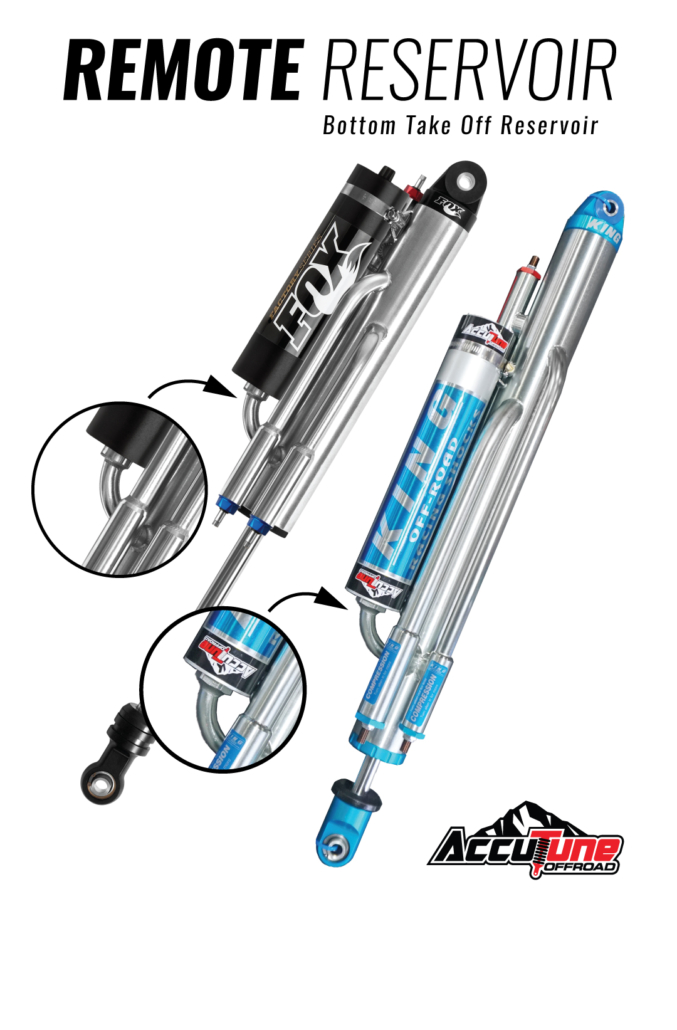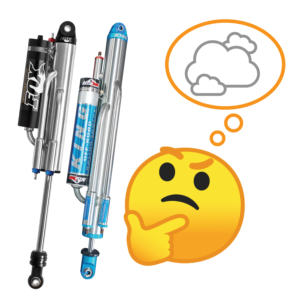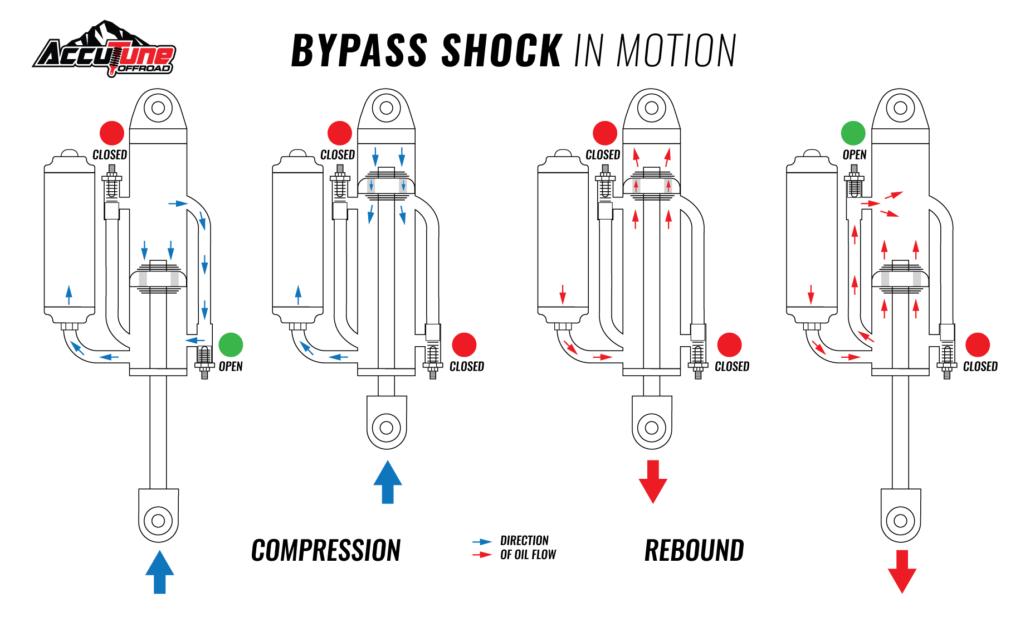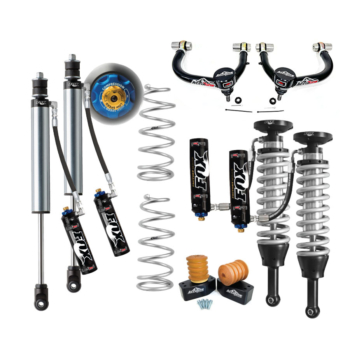March 9, 2021
Bypass Shocks PART 1
- How do Bypass Shocks Work?
- Shock Zones & Basic Tube Layout
- Bottom Take Off Reservoir
- Off the Shelf Options
- Multiple Compression and Rebound Tubes
- Staggered vs Overlapping Tubes
- Piggyback vs Remote Reservoir
- Shock Diameter
- Tube Layout Around Body
- Tube Heights & Diameter
- Custom Setup Recommendations
- Fox vs King Comparison
- Check Valve Design
- Pistons
- Bypass Adjusters Screws
- Piston Rods
- Oil Seals
- Bypass Shock Setup
- Up Travel
- Motion Ratio – Coilover & Bypass
- Total Weight
- Weight Distribution (front/rear)
- Unsprung Weight
 Bypass shocks for your off-road vehicle can be a huge performance upgrade, as long as they are set up properly. With the correct size shock body, stroke length, bypass tube layout and tuning they can be incredible for hardcore off-road driving. In this series of articles, we break down how bypass shocks function, the pros and cons of different setups, and how they can be customized for your suspension setup.
Bypass shocks for your off-road vehicle can be a huge performance upgrade, as long as they are set up properly. With the correct size shock body, stroke length, bypass tube layout and tuning they can be incredible for hardcore off-road driving. In this series of articles, we break down how bypass shocks function, the pros and cons of different setups, and how they can be customized for your suspension setup.
How do Bypass Shocks Work?
Bypass shocks work by allowing oil to flow through tubes around the main shock piston. Each tube contains a check valve only allowing oil to flow in one direction. By stacking bypass tubes around the body at different heights the shock will have softer and stiffer zones. The stiffness in each zone is controlled by the diameter of the bypass tube, and how far the check valve is allowed to open (external adjustment).
 Bypass Shock Check Valves
Bypass Shock Check Valves
At the end of the bypass tube there is a locknut, adjusting screw, plunger, and check valve. When oil is flowing through the bypass tube, the check valve is pushed back to the Back Stop Plunger. The distance in which the check valve can be pushed back is adjusted by the Adjustment Screw. The greater the distance the check valve is able to travel, the more fluid is able to flow through. Once adjustments have been made the lock nut will keep it from moving.
 Bottom Take Off Reservoir
Bottom Take Off Reservoir
On most traditional shocks the remote reservoir comes off the top of the shock, but on bypass shocks they almost exclusively come off the bottom. In a normal top take-off shock the compression damping is resisted by the nitrogen charge and restriction from the reservoir hose. Due to these factors there is a range of speeds and forces where a top take off shock may stop providing more damping with higher velocity. The shock stops making more force because the IFP has been pushing into the reservoir, compressing the nitrogen more, and leaving a vacuum underneath the piston. As the shock slows down and reverses to rebound the piston can slap back to fill the void causing a loss of damping in rebound too. By moving the reservoir to a bottom take-off configuration bypass shocks provide more consistent damping.
 Bypass Shock Zones
Bypass Shock Zones
Because bypasses are position sensitive, it is possible for the tubes to be positioned wrong which can cause the shock to be too stiff and jarring, too soft and bouncy, or to be untunable all together. The height position of bypass tubes relative to the piston are very important for proper function. For a 2-tube bypass shock, there are mainly 3 zones in which the shock will be affected by valving and compression tubes. Bump Zone is where the shock will be close to bottoming out completely and the piston has passed all the bypass tubes. Ride Zone will be where your vehicle will sit at ride height and ride at most of the time. Top Out Zone will be when the shock is fully extended and the piston has passed all the rebound tubes.
Summary
The performance of a shock is ultimately dictated by its tunability. Tunability in all shocks relates to our ability to control the force of the shock at a wide range of shaft speeds. For example, shocks that don’t flow enough oil ride rough because oil flowing through a fixed orifice make forces exponentially. Bypass shocks can have similar performance when the internal valving is stiff and the tubes are too small. What makes bypass shocks so great, is what also makes them a bit complex. With that in mind, it’s important to have the correct bypass shock setup on your vehicle, if a bypass shock is even needed.
Bypass Shock Part I FAQ:
 Do I need Bypass Shocks?
Do I need Bypass Shocks?
Bypass shocks have stiff zones and soft zones. Without adequate amounts of up travel there isn’t room for each zone to do their job well and you may end up with shocks that are too soft or too stiff. For applications with less than 5″ of up travel bypass shocks are not recommended.
Bypass shocks are all about off-road performance. If you are shooting for the best on-road ride and don’t plan to charge whoops off-road then bypass shocks may not be the best choice for you. Due to their construction bypass shocks can ride rougher on-road, so if you don’t need the off-road performance they may not deliver what you are looking for.
 When should you consider a bypass shock vs a smoothie?
When should you consider a bypass shock vs a smoothie?
Bypass shocks are more expensive and more complicated than smoothies which means they require more work. If you put the time into purchasing high quality bypass shocks, have them set up correctly, and tune them they can work exceptionally well for most setups. If you aren’t willing or able to do all of that, you may be better off with a properly tuned smoothie shock. Cheap bypasses and incorrectly set up bypasses have lower performance and lower comfort than smoothies.
Because bypass shocks are position sensitive, vehicles that experience large changes in ride height (probably due to varying loads) are not a good choice for bypass shocks. When the vehicle raises or lower the bypass shocks will likely end up riding in the wrong zone, which can cause harshness or bounciness. For this situation smoothies with compression adjusters are preferred.
 Bypass shock with leaf spring vehicle good vs bad?
Bypass shock with leaf spring vehicle good vs bad?
Leaf springs and bypasses can work well together, but you need to put the time into tuning them. Due to the design of bypass shocks there is not a great way to specifically tune low speed damping which controls the bounciness and performance on g-outs. On a traditional coilover and bypass setup we are able to tune the coilover to control the low speed damping and use the bypass primarily for high speed damping. But on a leaf spring setup there is no coilover, so the bypass has to do both. This setup can work, but it does take a lot more tuning than a coilover and bypass setup.













